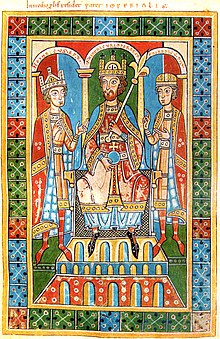Barbarossa privilege

With the Barbarossa privilege of September 19, 1188, the Roman-German Emperor Friedrich I specifically promoted the economic development of the city of Lübeck into a northern European trading center.
Lübeck, located on the southern coast of the Baltic Sea , was re-established in 1158 by Friedrich's cousin Heinrichs the Lion after a devastating fire the year before . After Heinrich's disempowerment in 1180, Lübeck first came into imperial possession. In order to secure the stormy development of the city, Friedrich furnished it with land and rights of use in the surrounding area.
The sovereign rights on the Stecknitz river as far as Mölln were particularly important . With the construction of the Stecknitz Canal and the pledging of the city of Mölln , this legal position was developed over the centuries into a key position for Lübeck's trading power.
The land and sea borders established by the emperor at the time, as well as the fishing rights to the Trave , Dassower See and in the Lübeck Bay were in dispute for centuries. In a legal dispute between Mecklenburg-Schwerin and Mecklenburg-Strelitz on the one hand and Lübeck on the other hand before the Imperial Court in 1890, the certificates of privilege were still used; In the 1928 dispute over sovereign rights in the Bay of Lübeck (the Bay of Lübeck case ), however, the State Court of Justice for the German Reich determined that the privileges no longer represented a legal basis.
Numerous parishes in the Klützer Winkel find their first documentary mention in the document in connection with the logging rights granted to Lübeck in the Klützer Forest . The Barbarossa privilege also secured the use of grassland in the vicinity of the city. Those affected by these rights of use, Count Adolf III. von Schauenburg and Holstein and Count Heinrich von Ratzeburg were to be compensated by the citizens of Lübeck for granting these rights of use.
The original of the Barbarossa privilege is no longer preserved. Since 1914, based on written comparisons, it has been known that the copy kept in the archives of the Hanseatic City of Lübeck must be a forgery that was made by the Lübeck canon Marold around 1225/26. The forgery was presented to Barbarossa's grandson, Emperor Friedrich II. , In Italy in May 1226 for confirmation in order to strengthen Lübeck's position in the process of breaking away from the supremacy of King Waldemar II of Denmark and against the Holstein Counts of Schauenburg . In May 1226, Emperor Friedrich II confirmed his grandfather's privileges and in June 1226 also issued the Lübeck council messengers in Fidenza with the Lübeck Imperial Freedom Letter , with which Lübeck became directly imperial . This paper layer was then turned into reality in the following year through the battle of Bornhöved .
literature
- Fritz Rörig : Again Mecklenburg coastal waters and Travemünder roadstead , in: ZVLGA 24 (1928), pp. 1 to 152.
- Olaf Ahlers (ed.): Lübeck 1226 - Imperial freedom and early city. Lübeck 1976.
- Antjekathrin Graßmann (Ed.): Lübeckische Geschichte. 2nd edition, Lübeck 1989. ISBN 3-7950-3203-2
- Antjekathrin Graßmann (Ed.): Lübeck-Lexikon, Lübeck 2006. ISBN 3-7950-7777-X
- Meike Kruse: For the indexing of the holdings of the archive of the Hanseatic City of Lübeck that were relocated in 1942/43 and returned between 1987 and 1998. In: The memory of the Hanseatic city of Lübeck: Festschrift for Antjekathrin Graßmann on the 65th birthday. In connection with the Association for Lübeck History and Archeology and the Hanseatic History Association ed. by Rolf Hammel-Kiesow and Michael Hundt. Lübeck: Schmidt-Römhild 2005, pp. 571-583, ISBN 3-7950-5555-5
- Gerhard Schneider: Endangering and Loss of Statehood of the Free and Hanseatic City of Lübeck and its Consequences ; Lübeck: Schmidt-Römhild, 1986 (publications on the history of the Hanseatic city of Lübeck; Vol. 14: Series B); ISBN 3-7950-0452-7
- Helmut G. Walther: Kaiser Barbarossa's certificate for Lübeck from September 19, 1188. In: ZVLGA 69 (1989), pp. 11-48.
Web links
Single receipts
- ^ Document book of the city of Lübeck (UBStL) I, No. 7 = Mecklenburgisches Urkundenbuch I, 143
- ↑ UBStL I, 34.
